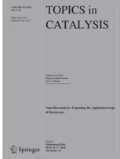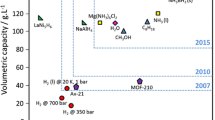Abstract
We investigate the relationship between the H\(_2\):NO ratio and NH\(_3\) formation over alumina supported Pt and Pd catalysts. By kinetic studies and in situ infrared spectroscopy, we report that NH\(_3\) formation is not only sensitive to the catalyst formulation but equally dependent on the feed gas composition and temperature. Specifically, we identify that hydrogen plays an important role in the dissociation of NO at low temperature. We also show that the support material itself plays a vital role in the ammonia formation mechanism due to the redox behaviour of NO adsorption at low temperature. This was unexpected as the noble metal is generally considered to be the active phase for the reaction of NO and H\(_2\).




Similar content being viewed by others
References
DiGulio CD, Pihl JA, Parks JE II, Amiridis MD, Toops TJ (2014) Catal Today 231:33–45
Prikhodko VY, Parks JE, Pihl JA, Toops J (2014) SAE Int J Engines 7:1235–1243
Oh SH, Triplett T (2014) Catal Today 231:22–32
Macleod N, Cropley R, Keel JM, Lambert M (2004) J Catal 221:20–31
Balle P, Geiger B, Klukowski D, Pignatelli M, Wohnrau S, Menzel M, Zirkwa I, Brunklaus G, Kureti S (2009) Appl Catal B 91:587–595
Cho YS, Lee SW, Choi WC, Yoon YB (2014) Int J Automot Technol 15:723–731
Can F, Courtois X, Royer S, Blanchard G, Rousseau S, Duprez D (2012) Catal. Today 197:144–154
Xu J, Clayton R, Balakotaiah V, Harolk MP (2008) Appl. Catal. B 77:395–408
Adams EC, Skoglundh M, Folic M, Bendixen EC, Garbrielsson P, Carlsson P-A (2015) Appl Catal B 165:10–19
Kannisto H, Karatzas X, Edvardsson J, Pettersson LJ (2011) Appl Catal B 104:74–83
Stenger HG Jr, Hepburn JS (1987) Energy Fuels 1(5):412–416
Kobylinski TP, Taylor BW (1974) J Catal 33:376–384
Almusaiteer K, Chuang SC (1998) J Catal 180:161–170
Macleod N, Lambert RM (2003) Appl Catal B 46:483–495
Iglesias-Juez A, Hungría AB, Martínez-Arias A, Fuerte A, Fernández-García M, Anderson JA, Conesa JC, Soria J (2003) J Catal 217:310–323
Hixson BC, Jordan JW, Wagner EL (2011) J Phys Chem A 115:13364–13369
Yang J-B, Fu O-Z, Yong D-Y, Wang S-D (2004) Appl Catal B 49:61–65
Neyertz C, Volpe D, Perez D, Costilla I, Sanchez M (2009) Appl Catal A 368:146–157
Hadjiivanov K, Saussey J, Freysz JL, Lavalley JC (1998) Catal Lett 1998:103–108
Toops TJ, Smith DB, Epling WS, Parks JE, Partridge WP (2005) Appl Catal B 58:255–264
Kijlstra WS, Brand DS, Poels EK (1997) J Catal 171:208–218
Prinetto F, Ghiotti G, Nova I, Lietti L, Tronconi E, Forzatti P (2001) J Phys Chem B 2001:12732–12745
Chien S-H, Kuo M-C, Lu C-H, Lu K-N (2004) Catal Today 97:121–127
Miller DD, Chuang SSC (2009) J Taiwan Inst Chem E 40:613–621
Farberow CA, Dumesic JA, Mavrikakis M (2014) ACS Catal 4:3307–3319
Huai L-Y, He C-Z, Wang H, Wen H, Yi W-C, Liu J-Y (2015) J Catal 322:73–83
de Wolf CA, Nieuwenhuys BE (2000) Surf Sci 469:196–203
Acknowledgments
This work was financially supported by the Swedish Energy Administration through the FFI program and the Competence Centre for Catalysis, which is financially supported by Chalmers University of Technology, the Swedish Energy Agency and the member companies: AB Volvo, ECAPS AB, Haldor Topsøe A/S, Volvo Car Corporation, Scania CV AB, and Wärtsilä Finland Oy.
Author information
Authors and Affiliations
Corresponding author
Rights and permissions
About this article
Cite this article
Adams, E.C., Skoglundh, M., Gabrielsson, P. et al. Passive SCR: The Effect of H\(_2\) to NO Ratio on the Formation of NH\(_3\) Over Alumina Supported Platinum and Palladium Catalysts. Top Catal 59, 970–975 (2016). https://doi.org/10.1007/s11244-016-0576-0
Published:
Issue Date:
DOI: https://doi.org/10.1007/s11244-016-0576-0




